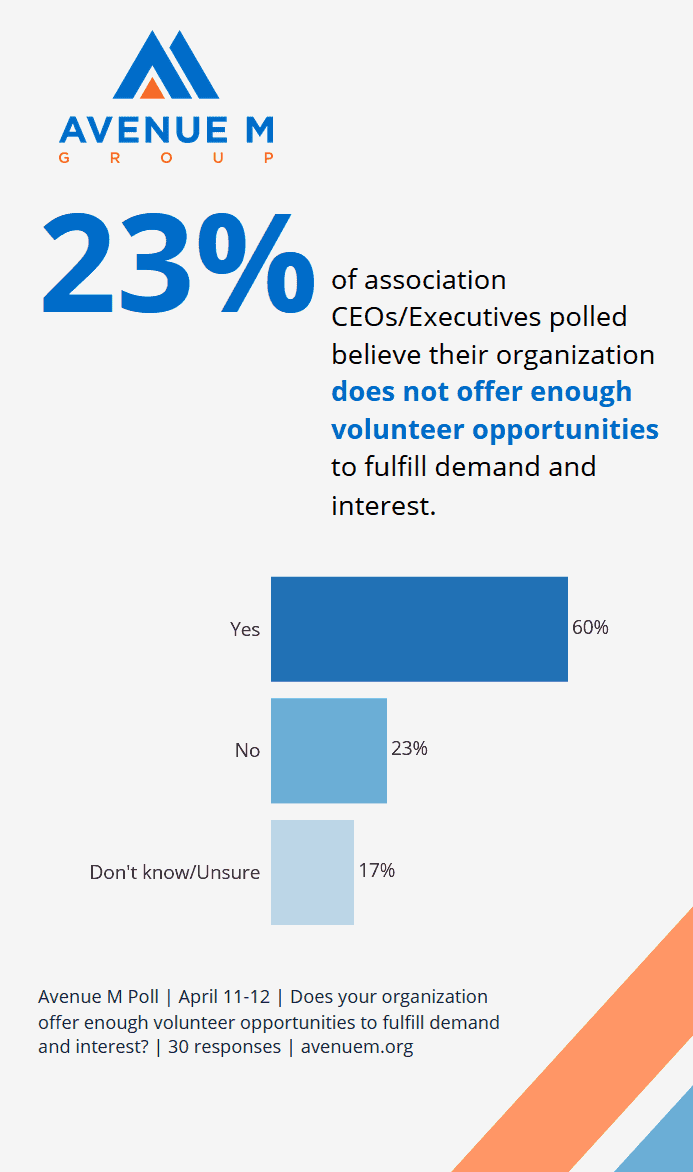Many associations report that despite the pandemic, volunteering is rebounding.
There are many benefits to volunteering for associations, including developing new skills, networking, and the personal gratification that comes from giving back to a profession or advancing a cause.
However, like many integral parts of association life, volunteering took a hit during the pandemic, especially with the shift from in-person to remote, which created several challenges. Associations had to quickly find new ways to sustain volunteering in a completely altered landscape.
As with many other association functions, the unexpected opportunity to look at volunteers and their contributions in a new light has brought about some constructive changes and new approaches to defining and measuring the success of volunteer roles and outcomes.
It also appears that now that life has edged back toward a more normal rhythm, and in-person activities have resumed, volunteering is on an upswing. Our panelists share their observations.

According to a recent poll conducted by Avenue M with its panel of CEOs and senior executives in early April, 60 percent report that their organizations offer enough volunteer opportunities to fulfill demand and interest. 23 percent said their organization does not offer enough volunteer opportunities, and 17 percent said they didn’t know or were unsure.
When asked if interest in volunteerism had changed since the beginning of the pandemic, several of our panelists weighed in. “We are seeing an increased interest,” one panelist shared. “Members see it as an opportunity to connect and engage.”
Another executive said, “Volunteer interest in activities is up slightly.”
One panelist noted that while they have seen “a significant dip in engagement since the pandemic,” their organization has responded with “increased engagement opportunities.”
Another leader, who said they did not offer enough volunteer opportunities to fulfill demand and interest, said, “We’re seeing less volunteers since the pandemic began.”
Recent findings from an ASAE Research Foundation report, A Holistic Approach to Volunteer Management, also show that the pandemic has not reduced volunteer engagement. Instead, the number of volunteers has increased or remained stable over the past three years.
Click HERE to participate in future polls.
For more insights and strategies on maximizing the volunteer experience, read our quick summaries of the following articles and click the links below.
How KPIs Can Make Volunteer Groups More Successful
Implementing key performance indicators (KPIs) can clarify volunteer responsibilities, frame initiatives, and track goals.
Jessica Irizarry, at the American Society of Interior Designers, decided to use KPIs for the first time this year as a way to measure the performance of the volunteer groups she manages.
She recommends several strategies, including aligning standard activities to the association’s core values and mapping special initiatives and projects back to those key tenets. Developing KPIs can also help volunteers maximize their time and understand their roles, and tracking output and outcome metrics can show volunteers the impact of their work.
Volunteers Get Burnout Too—But You Can Help Prevent It
Volunteer burnout can be a major concern for associations, but there are ways to rekindle the spark of volunteering. Making work mission-driven, showing appreciation, focusing on what volunteers can get out of it, and offering flexibility can all help.
Microvolunteering and expanding volunteer options can also make a big difference in engaging and retaining volunteers. By easing the potential for volunteer burnout, associations can boost engagement and strengthen their communities.
How to Fix the Disconnect Over Volunteer Effectiveness
Associations often struggle with defining the role and effectiveness of volunteers, causing a disconnect between staff and volunteers. Successful volunteering requires clarity, commitment, and a system built for outcomes.
Despite the pandemic, the appetite for volunteering remains stable or has increased, but associations need to move away from familiar names and towards inclusive recruitment processes to fill skills gaps and ensure diversity.
Want to be the first to be notified about articles like this?
You can learn more about Avenue M’s texting poll service HERE.
Ready to sign up? Click HERE.
Contributors: Sheri Jacobs, FASAE, CAE & Lisa Boylan
(Image: Adobe Stock)